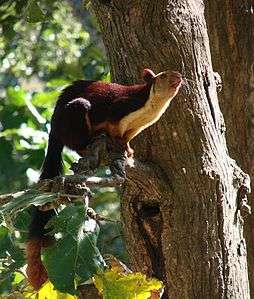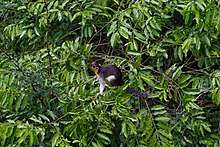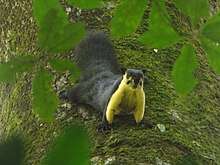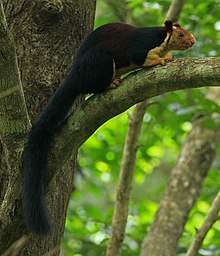Oriental giant squirrel
Oriental giant squirrels are cat-sized tree squirrels from the genus Ratufa in the subfamily Ratufinae. They are a distinctive element of the fauna of south and southeast Asia.
| Oriental giant squirrels Temporal range: Middle Miocene to Recent | |
|---|---|
 | |
| Indian Giant Squirrel (Ratufa indica) | |
| Scientific classification | |
| Kingdom: | Animalia |
| Phylum: | Chordata |
| Class: | Mammalia |
| Order: | Rodentia |
| Family: | Sciuridae |
| Subfamily: | Ratufinae Moore, 1959 |
| Genus: | Ratufa Gray, 1867 |
| Species | |
|
Ratufa affinis | |
| Synonyms | |
|
Eoscuirus | |
Species
There are four living species of oriental giant squirrels:
| Image | Common Name | Scientific name | Distribution |
|---|---|---|---|
 | Cream-coloured giant squirrel | Ratufa affinis | Thai-Malay Peninsula, Sumatra (Indonesia), Borneo (Brunei, Indonesia and Malaysia) |
 | Black giant squirrel | Ratufa bicolor | northern Bangladesh, northeast India, eastern Nepal, Bhutan, southern China, Myanmar, Laos, Thailand, Malaysia, Cambodia, Vietnam, and western Indonesia (Java, Sumatra, Bali and nearby small islands) |
 | Indian giant squirrel | Ratufa indica | India. |
 | Grizzled giant squirrel | Ratufa macroura | Tamil Nadu, India. |
In prehistoric times this lineage was more widespread. For example, animals very similar to Ratufa and possibly belonging to this genus–at least belonging to the Ratufinae–were part of the early Langhian (Middle Miocene, some 16–15.2 million years ago) Hambach fauna of Germany.[1]
Skeleton of a Ratufa species
gollark: ++remind 4d12h-3m preeeëmpt palaiologos/sofia
gollark: ... when did camto sign up
gollark: Yes, they should submit to the equally userless apioforum at https://forum.osmarks.net/.
gollark: I like the way the nim forum works and thought "why NOT use forum software written like heavpoot wrote it?".
gollark: Store the ENTIRE REGISTRY EVER muahahaha.
References
- Gee, Carole T.; Sander, P. Martin; Petzelberger, Bianka E .M. (2003). "A Miocene rodent nut cache in coastal dunes of the Lower Rhine Embayment, Germany". Palaeontology. 46 (6): 1133–1149. doi:10.1046/j.0031-0239.2003.00337.x.
This article is issued from Wikipedia. The text is licensed under Creative Commons - Attribution - Sharealike. Additional terms may apply for the media files.